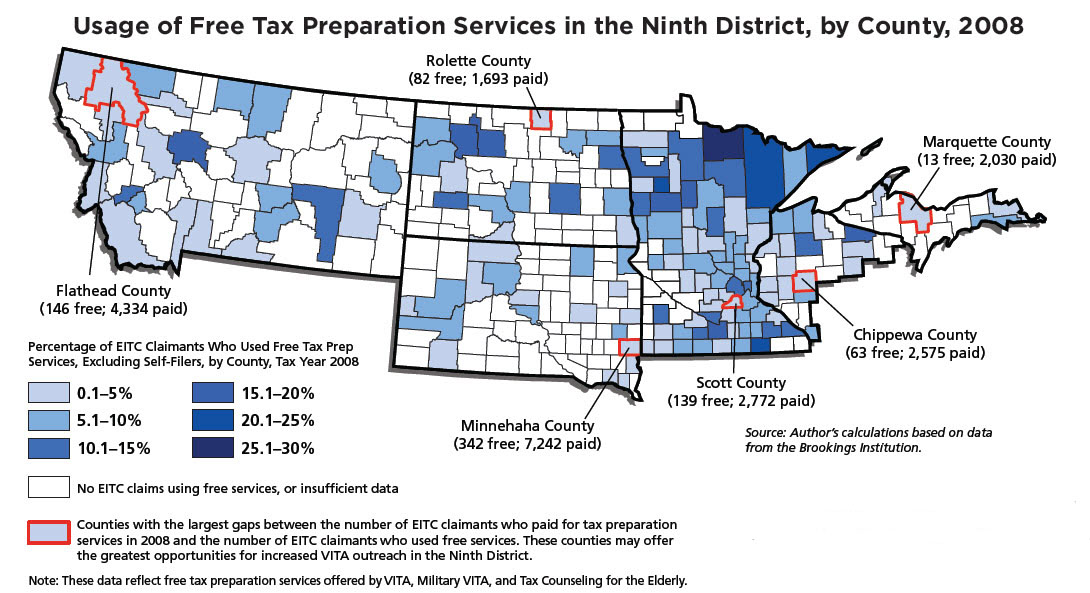Five years ago, Community Action Duluth (CAD) opened its second tax preparation site, at a West Duluth community center, 1/ with the goal of encouraging eligible area residents to have their tax returns prepared there for free.
“We understood that people didn’t have time to wait in line all day, so we opened a ‘family site’ tax center that offered scheduled appointments and child care,” explains Angie Miller, executive director of CAD.
Despite quadrupling its customer base since 2005, CAD—like scores of other organizations in the Internal Revenue Service’s Volunteer Income Tax Assistance (VITA) program—continues to search for ways to attract more low-income tax filers to its offices. The potential for more outreach is reflected in data on filings for the federal Earned Income Tax Credit (EITC), which show that many low-income workers pass on free services available to them through volunteer tax preparation organizations, like CAD, and instead pay to have their taxes prepared.
“We started offering these services after many of our clients expressed regret about using commercial preparers,” says Miller. “Some people were losing out on hundreds of dollars, and what really stung was that these fees would have been avoidable had they used our services.”
EITC take-up by the numbers
Out of the 4.2 million tax returns filed for fiscal year 2008 across the Ninth Federal Reserve District, more than 550,000 tax filers, or 13 percent, received the EITC, for an average benefit of roughly $1,800 per filer.2/ While statewide percentages of tax filers who received the EITC fell in a fairly narrow range, from a low of 11.9 percent in Minnesota to a high of 16.3 percent in Montana, the percentage of EITC claimants who used free, third-party tax preparers varied widely. Excluding self-filers, Minnesota led the Ninth District in this category, with nearly 1 in 10 EITC claimants taking advantage of free tax preparation services. At the low end were Wisconsin and South Dakota, where 1 in 30 EITC claimants used a free service, and the Upper Peninsula of Michigan, where just 1 in 150 EITC claimants used a free service.
VITA sites fine-tune their outreach strategies
For Tax Help Montana, a coalition of VITA sites in more than 30 communities and American Indian reservations in Montana, finding ways to attract eligible tax filers to their offices is a blend of both formal and informal outreach efforts.
“About three-quarters of our new customers learn of our services through word of mouth and through our partnerships with organizations and offices that operate programs directed toward low-income residents, like Head Start and TANF [Temporary Assistance for Needy Families], and people who are getting childcare scholarships,” says Karen Heisler, director of asset development at Rural Dynamics, a consumer credit counseling agency that coordinates the Tax Help Montana coalition. “But we also run public service announcements on the radio, distribute door hangers in neighborhoods that have a lot of low-income residents, and use posters at community centers.”
Heisler also explains that the school district in Helena permitted Tax Help Montana to notify parents of the free tax sites in the area by including a flier in students’ weekly take-home paperwork.
Like Tax Help Montana, CAD reaches clients through word of mouth and print and radio ads, but it also advertises its free tax services through an insert placed in water and gas bills. According to Miller, more than 20 percent of CAD’s clients for tax year 2011 learned of the free tax preparation services through the insert and the organization’s other mailings. She also stresses that CAD seeks to accommodate clients’ schedules by offering tax services at three different locations during a range of times, including evening and Saturday hours.
AccountAbility Minnesota (AAM), a Twin Cities-based nonprofit organization that provides free tax preparation and financial services, distributes tens of thousands of brochures to prior-year customers and to social service and economic development organizations that work with low- and moderate-income (LMI) individuals. AAM also seeks news coverage from broadcast and print media outlets and manages a statewide EITC campaign, Claim It!, that advertises on billboards, bus placards, and more.
Tracy Fischman, AAM’s executive director, sums up the importance of serving LMI individuals at free tax preparation sites: “At commercial preparers, people often pay hundreds of dollars to have their taxes prepared and filed and to claim all tax refunds they have earned. When they come to a free tax site, they get to keep all of that extra income.”
In Brief
What is the Earned Income Tax Credit?Created in 1975, the Earned Income Tax Credit (EITC) is an Internal Revenue Service (IRS)-administered refundable tax credit available to low- and moderate-income workers. The credit reduces an individual’s tax burden, which may result in a refund. For tax year 2012, the income ceiling for claiming the EITC will range from $13,980 to $50,270, depending on filing status and the number of qualifying children. The maximum credit will be $475 to $5,891. To receive the EITC, workers must file a federal tax return, even if they are not otherwise required to file because their incomes are so low. |
The Volunteer Income Tax Assistance (VITA) programInitiated in 1969, the IRS’s Volunteer Income Tax Assistance (VITA) program is a network of organizations and volunteer sites where people with incomes under $50,000 can receive free tax preparation services. To locate a VITA provider, visit the IRS’s VITA locator page at http://irs.treasury.gov/freetaxprep. |
 click to view larger image
click to view larger image
 click to view larger image
click to view larger image
1/ This tax site has since moved to Duluth’s Laura MacArthur Elementary School.
2/ Data from the Brookings Institution, available at www.brookings.edu/about/programs/metro/eitc/eitc-homepage.





